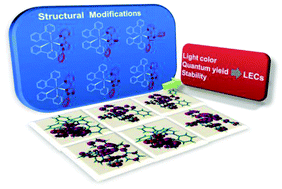A theoretical study on supramolecularly-caged positively charged iridium(iii) 2-pyridyl azolate derivatives as blue emitters for light-emitting electrochemical cells†
Abstract
The photophysical and optical properties of a series of charged biscyclometalated [Ir(ppyn)2(N^Nn)]+ complexes have been investigated with density functional theory, where ppy0 = 2-phenylpyridine; ppy1 = 2-(2,4-difluorophenyl)pyridine; N^N = 2-(1-phenyl-1H-pyrazol-3-yl)pyridine (1a, 1b); 2-(4-phenyl-1H-imidazol-2-yl)pyridine (2a, 2b); 2-(1,4-diphenyl-1H-imidazol-2-yl)pyridine (3a, 3b); 2-(2-phenyl-2H-1,2,3-triazol-4-yl)pyridine (4a, 4b); 2-(1-phenyl-1H-1,2,4-triazol-3-yl)pyridine (5a, 5b); 2-(3-(pyridin-2-yl)-1H-1,2,4-triazol-1-yl)pyridine (6a, 6b); 2-(1H-pyrazol-1-yl)pyridine (7a, 7b), respectively. The calculated results reveal that both the difluoro-substituent and the different 2-pyridyl azolate ancillary ligands have a large influence on tuning the emission energies and quantum yields of the studied complexes. On the basis of the results reported herein, we attempt to explain the experimental observation that the complexes 7a and 7b show high quantum phosphorescence efficiency (ΦPL) of 23% and 20% compared with 1a with ΦPL of 3%. To clarify this behavior, the metal-to-ligand charge transfer contributions (MLCT%), the S1–T1 splitting energy (ΔES1–T1) and the transition dipole moment (μS1) upon the S0→S1 transition were calculated. Drastically small ΔES1–T1 and large MLCT% for 7a (0.06 eV and 28.2%, respectively) and 7b (0.08 eV and 24.6%, respectively) compared to those for 1a (0.60 eV and 19.5%, respectively) account for their relatively high ΦPL observed experimentally. Besides, the remarkably small ΔES1–T1, large MLCT% and similar μS1 for 2a (0.04 eV, 29.1% and 0.026 D, respectively) compared with those for 2b (0.56 eV, 2.3% and 0.022 D, respectively) could be interpreted by the difluoro-substituent effects. Furthermore, 2a–4a and 4b–5b are considered to have relatively better physical properties with respect to the experimentally synthesized complexes 7a, 7b and 1a. Therefore, the newly designed complexes 2a–4a and 4b–5b are expected to be highly efficient sky-blue and blue-green emitters for LEC application.


 Please wait while we load your content...
Please wait while we load your content...